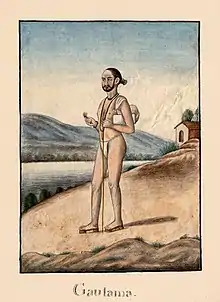Gautama Maharishi
Gautama Maharishi (Sanskrit: महर्षिः गौतम Mahariṣiḥ Gautama), also known as Vamadeva Gautama[1] was a Rigvedic sage in Hinduism, who is also mentioned in Jainism and Buddhism. Gautama is prominently mentioned in the Ramayana and is known for cursing his wife Ahalya, after she had an relationship with Indra. Another important story related to Gautama is about the creation of river Godavari, which is also known as Gautami.
Gautama Maharishi | |
|---|---|
 An Early 19th Century Painting Showing Maharishi Gautama | |
| Personal | |
| Religion | Hinduism |
| Spouse | Ahalya |
| Children | Shatananda and others |
| Parents |
|
| Honors | One of the Saptarishis (Seven Great Sages Rishi) |
| Part of a series on | |
| Hindu philosophy | |
|---|---|
 | |
| Orthodox | |
|
|
|
| Heterodox | |
|
|
|
History
Gautama was the founder of the Vamadeva family. Most of the hymns in Mandala IV of the Rigveda are attributed to him.[1] He was the son of Gotama.[2]
Children
According to Valmiki Ramayan, Gautama's eldest son with Ahalya is Satananda. But according to Adi Parva of Mahabharata, he had two sons named Saradvan and Cirakari. Saradvan was also known as Gautama, hence his children Kripa and Kripi were called Gautama and Gautami respectively. A daughter of Gautama is referred too but her name is never disclosed in the epic.[3] According to Vamana Purana, he had three daughters named Jaya, Jayanti and Aparajita.[4]
Ahalya's curse

The Ramayana describes Ahalya as his wife. Their marriage is recorded in the Uttara Kanda, which is believed as an interpolation to the epic. As per the story Brahma, the creator god, creates a beautiful girl and asks Gautama to take care of her until she reaches puberty. Years after, Gautama returns. Brahma, pleased with Gautama's control over his desires, gifts her as a bride. Gautama marries her and a son named Shatananda is born. The Bala Kanda mentions that Gautama spots Indra, who is still in disguise, and curses him to lose his testicles. Gautama then returns to his ashram and accepts her.
Godavari's creation

Brahmadev worshipped God Trivikram when he came to Satya Loka (on earth) with the same holy water of the Ganges, to get the river Ganges held up by God Shankar on his head, to flow. There was a famine of 24 years and people were affected by the pangs of hunger. However, Varun – the God of Rains, pleased with Sage Gautama arranged rains every day in Gautama's Ashram (dwelling place) which was in Trimbakeshwar. Gautama used to sow rice in the surrounding fields of his Ashram in the morning, reap the crop in the afternoon and with it fed a large group of Hrishis, who took shelter in his Ashram on account of the famine. The blessings of the group of rishis increased the merit (Punya) of Gautama. Lord Indra's position became shaky because of his increased merit. So Indra ordered clouds to rain all over Trimbakeshwar, so that the famine will be over and rishis will go back and the increasing merits of Gautama will be weakened. Although the famine was over, Gautama urged the Rishis to stay back and kept on feeding them and gaining merit. Once he saw a cow grazing in the paddy field and he drove her away by throwing Darbha (sharp, pointed grass). The slender cow died by this. It was Jaya – Parvati's friend, who had taken the form of a cow. This news upset the Rishis and they refused to luncheon at his Ashram. Gautama requested Rishis to show a way out of this sin. He was advised to approach Lord Shiva and request him to release the Ganges and a bath in the Ganges would set him free of his sins. Gautama then practiced penance by going to the peak of Brahmagiri for 1000 years. Lord Shankara was pleased by his worships and gave him the Ganga. However, Ganges was not prepared to part with Lord Shiv, which irritated him. He made TandavNrutya (dance) on the peak of Brahmagiri and dashed his jata there. Frightened by this action, Ganges appeared on Brahmagiri. Later on, Ganges appeared in the Trimbak Tirtha. Gautama praised her but she off and on appeared on the mountain at various places and disappeared in anger. Gautama could not bathe in her waters. The Ganges then appeared in Gangadwar, Varaha-tirtha, Rama-Laxman tirtha, Ganga Sagar tirtha. Still, Gautama could not bathe in her waters. The Gautama surrounded the river with enchanted grass and put a vow to her. The flow stopped there and the tirtha thus came to be called Kushavarta. It is from this Kushavarta that the river Godavari flows up to the sea. The sin of killing a cow by Gautama was wiped off here.
References
- Jamison, Stephanie; Brereton, Joel P. (2014). The Rigveda - the earliest religious poetry of India. Oxford University Press. p. 556.
- Jamison and Brereton 2014, p. 563-564.
- "Puranic encyclopaedia: a dictionary with special reference to the epic and Puranic literature". archive.org. 1975.
- "Puranic encyclopaedia : a dictionary with special reference to epic and Puranic literature". archive.org. 1975.
- Doniger, Wendy (1999). "Indra and Ahalya, Zeus and Alcmena". Splitting the Difference: Gender and Myth in Ancient Greece and India. University of Chicago Press. ISBN 978-0-226-15641-5.